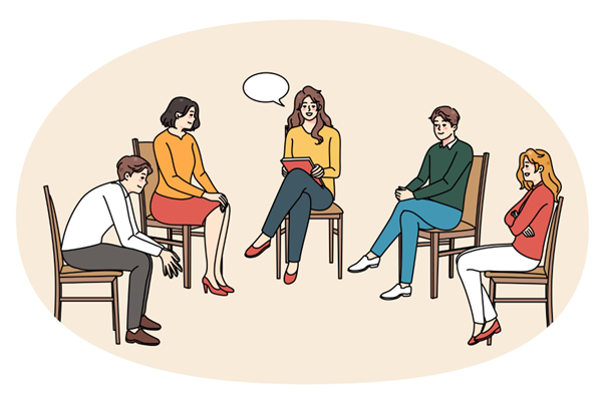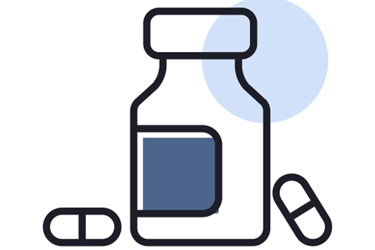Examination and treatment
What is an examination?
The examination begins even before your first appointment, when you fill out the questionnaires we send you via text message. During your first appointment, your therapist will continue to assess your life situation, as well as your mental distress and symptoms, to determine whether you have a mental disorder.
In this video, you'll receive a more thorough explanation of how an examination is conducted:
Summary:
- The goal of the examination is to determine whether you have a mental disorder and what kind of help you might need.
- Different mental disorders are treated in different ways, so it’s important to find the correct diagnosis.
- The length of examinations vary, but typically around three to four appointments are used for this process.
- During an examination, you will be asked a series of questions about your life and how you are feeling, and therapists often use what we call a diagnostic interview.
- Sometimes, the examination shows that you do not have a psychiatric disorder, and/or that the issues you are experiencing should be treated elsewhere, such as in primary healthcare services.
- If the examination shows that you should receive further help in specialized healthcare, you and your therapist will work together to create a treatment plan.
Follow-up and Treatment
Once the examination has been completed, your therapist will evaluate whether you have a psychiatric disorder. Then, together you will determine what type of follow-up will be most appropriate for you. If you and your therapist agree that you need and could benefit from further help at the hospital, you will work together to create a treatment plan that outlines what you hope to achieve from the treatment and approximately how long it is expected to last.
There are many different ways to receive help, and you can read about some examples of treatment on this page. Sometimes you may receive help with several issues during the treatment period, while other times the focus will be limited to a single issue.
It is also possible that the conclusion will be that you would receive better help elsewhere, such as through local community health services. You may also need a specific type of treatment that is not offered at the hospital. In such cases, your therapist can either refer you further or provide information on how to access the service that best suits your needs.

Finances, Housing, Work, and Studies
Illness often affects several aspects of life, including housing situation, finances, employment, and education. When facing a new life situation, it is important to be aware of your rights and responsibilities. Two important partners for many therapists and patients are therefore NAV (Arbeids- og velferdsetaten) and the local district where the patient lives.
NAV administers rights related to all stages of life. Their mission is to provide financial support, guidance, and services to ensure social and economic security, as well as to promote an inclusive working life.
The district/municipality offers many services that may be relevant at various stages of life. Housing and social services, as well as health and care services at this level, may be relevant before, during, and after treatment at the hospital.
In cooperation with your therapist, you can get help establishing contact with NAV and relevant services in your district. The hospital also has social workers who assist by providing information, advice, and guidance to therapists. At some of our outpatient clinics, your therapist can refer you to a social worker for more specific guidance in individual cases. Bring it up with your therapist if you believe you need assistance from a social worker. Your therapist can then send a referral, and the social worker will assess your case.
Here you will find an overview of the most common rights, responsibilities, and opportunities that may be important for you to be aware of.

Talk Therapy
All forms of talk therapy involve meeting with your therapist at regular intervals. Sessions usually last for 45 minutes at a time, but they can also be shorter or longer.
The purpose of talk therapy is to help you manage difficult emotions in ways that have less negative impact on your everyday life. You learn new ways to cope with challenges so that your symptoms and struggles become milder and/or less distressing. How this is achieved varies depending on the type of talk therapy the therapist uses. Authorized healthcare professionals are required to use therapy methods that are well-supported by research and have been shown to be helpful for many people.
Some forms of talk therapy focus on teaching patients to think and act differently in their daily lives. Other times, therapy is more about experiencing challenging emotions in the moment, during the session, in order to learn how to handle them in healthier ways. Some therapists use tools or techniques during therapy, while other sessions are centered solely around conversation. Regardless of the specific method your therapist uses, they will always focus on building a relationship with you that makes you feel safe and supported. That’s why it’s important to speak up if there’s something about the therapy that isn’t working well for you.
The Norwegian Centre for Violence and Traumatic Stress Studies (NKVTS) has created a short animated film that describes what it can be like to attend talk therapy. The film is originally intended for refugees and is therefore available in several languages. However, anyone who wants to learn more about what talk therapy involves may benefit from watching it. You can watch the film here.

Group Therapy
Group therapy is a form of talk therapy where several patients participate together. The groups usually consist of eight patients and two therapists. Sessions typically last between 1.5 to 2 hours each time, and patients are invited to speak together about topics related to the challenges they are experiencing. Group therapy is particularly relevant for conditions such as personality disorders, complex trauma-related conditions, and long-term depression.
In group therapy, there is a focus on group cohesion and mutual support among participants, as well as exploring similarities and differences, trying out new ways of relating to others, gaining experience with how one affects others, and increasing tolerance for both one’s own and others’ emotions.
For group therapy to be effective, it is especially important that participants are in a life situation that allows them to attend regular sessions one to two times a week over an extended period. It is also important that participants have a good command of the Norwegian language.

Courses
Some of our outpatient clinics offer patient courses focused on specific disorders and issues. Most of the courses are held in person at the hospital, while some are available online. In-person courses generally have between 8 and 10 participants.
The duration of each session and the number of meetings vary depending on the course. Some courses are intensive, with frequent sessions over a short period, while others are spread out over a longer timeframe. The courses are led by healthcare professionals from the hospital.
The courses provide participants with knowledge about the relevant disorder or issue, as well as practical advice on how to manage common challenges.

Medications
Some psychiatric disorders can be treated with medications, often in combination with talk therapy or other interventions. Sometimes, it is the general practitioner (fastlege) who assesses and monitors the use of medications, while at other times, it is the hospital's doctors who handle this. Doctors employed at the hospital are either specialists in psychiatry or in specialized training, and therefore have particular expertise in the use of medications in the treatment of psychiatric disorders.
Whether medications are appropriate for a specific patient is assessed during the course of treatment. Some patients may already be on medications, while others begin pharmacological treatment after completing the assessment. If medications are considered relevant for your treatment, this will be discussed with you by your therapist, and you will talk about it together. You can also ask your therapist any questions you may have.

Other Interventions
In addition to the various forms of follow-up and treatment mentioned so far, a treatment process will often also focus on important areas of daily life. Examples of such areas include exercise and physical activity, diet, sleep, social arenas, and involving family members. These are factors we know have an impact on mental health, and therefore it is natural to include them in treatment. These topics can be included in different ways, such as in therapy sessions, patient courses/specific group offerings, or in the form of self-help materials.

Feedback to Your Therapist
For treatment to be effective, you as a patient must actively participate throughout the process. This includes, among other things, contributing to setting goals for the treatment and working purposefully on making changes both during and between sessions. Your therapist can help you identify your goals and work with you to ensure the treatment is as effective as possible.
In most treatment processes with us, you will have the opportunity to provide feedback to your therapist through questionnaires sent to you via SMS. These questionnaires include questions about how you are doing during the treatment and how you are experiencing the therapy. It is highly beneficial if you respond to these questions. Your answers provide valuable information for your therapist, allowing you to spend more time focusing on what matters most to you. Therapists are used to receiving feedback and use it to tailor the treatment. That’s why it is important that you answer the questionnaires as honestly as possible.
